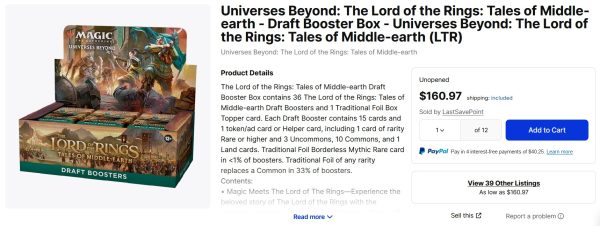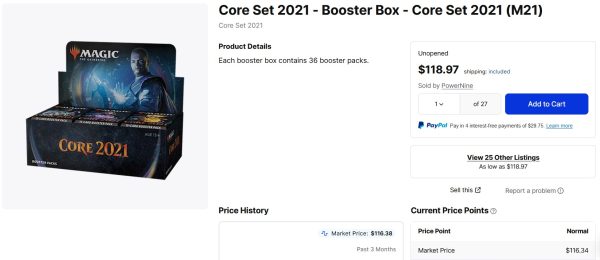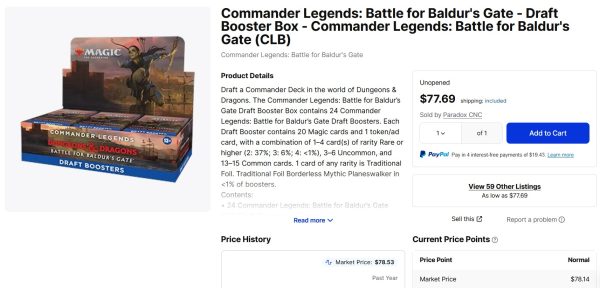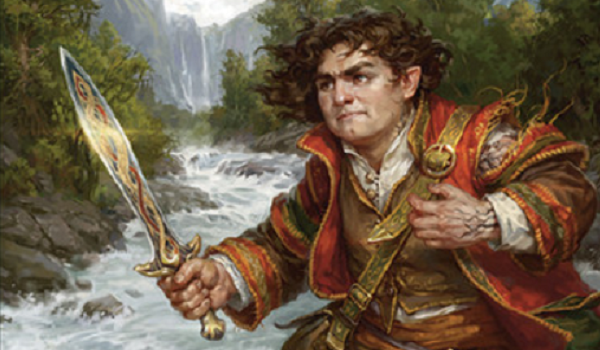Are you a Quiet Speculation member?
If not, now is a perfect time to join up! Our powerful tools, breaking-news analysis, and exclusive Discord channel will make sure you stay up to date and ahead of the curve.
After much-anticipated hype, The Lord of the Rings: Tales of Middle Earth has officially launched across the globe. At last, players can sleeve up their favorite characters from the trilogy and do battle. Despite not being Standard legal, the launch feels like a “normal” release because the set is available in draft boosters, set boosters, collector boosters, bundles, etc. The set is also available to draft on Arena.
With all this hype, I decided to swing by my local game store (LGS) to pick up a booster box of draft boosters to sit on for a bit. I figured it was a novel set with a strong tie to a world-renowned property, so it was bound to be a success.
Limited streamers with early access have already been sharing their enjoyment of the format, leaving me optimistic for another great draft set. A few commented that the set is a little powered down, much like your typical summer Core Set, but that doesn’t mean the set won’t be fun to draft. I was in.
Not Your Average Box
I arrived at the shop and asked how much the draft booster box of the new Lord of the Rings set cost. I was expecting the box to be marked up a little bit because I was purchasing from a small business, a brick-and-mortar store with overhead costs and all that. I was happy to support the shop, so I braced myself for something in the $120 range.
The answer made me do a double-take: $159.99. What?! For a core set?!
I kept my cool in the shop and pulled out my phone, checking TCGplayer to see just how much of a market my buddy at the LGS was charging me. Boy was I surprised!

He wasn’t up charging me a cent! In fact, his price was lower than what I could find on TCGplayer (box prices may have drifted a little lower since). The shop owner wasn’t padding his margins—instead, he was giving me a discount!
Why are boxes of this set—a set that my favorite Limited podcasts describe as akin to a “core set”—cost more than your typical Standard booster box?
A Straight-to-Modern Set
The piece I missed when I first read about this set was how Wizards of the Coast was treating its format legality. I knew the set wasn’t Standard legal, but beyond that, I wasn’t fully aware of how the set was being managed. According to my research, “While the set isn’t focused on Modern as a Modern Horizons set might be, R&D wanted to allow as many players to play with these cards and enjoy them.”
OK… Wizards of the Coast wants more players to enjoy these cards, so how does leaving them out of Standard enable that? This is perplexing to say the least, especially given the fact that these cards seem underpowered relative to other straight-to-Modern sets, such as Modern Horizons.
As such, it is my understanding that distributor pricing is in-line with sets like Modern Horizons and not like Core Set 2021, for example. A higher price at the distributor means game shops have to pay more for the product; a premium that they pass, in turn, to customers.

I did a Google search but couldn’t find any definitive source for the distributor prices of Tales of Middle Earth draft booster box prices. The only data point I found was mentioned by somebody on Reddit claiming the distributor box pricing is $200 CAD or about $150 in U.S. Dollars. A second commenter chimed in by stating that a $150 price point likely implies $110-$120 for “real” prices.
I don’t understand this rhetoric around “real” prices, but this Reddit contributor's number is plausible. If local game stores are paying upwards of $110-$120 for booster boxes, it seems reasonable they would charge between $150 and $160, at least at release.
Concerning Prospects
Draft booster boxes of previous straight-to-Modern sets have held up considerably well price-wise. Booster boxes of the first Modern Horizons sell for around $220 on TCGplayer, and the newer Modern Horizons 2 boxes sell in the $180 range. Granted, a year ago these were selling for around $210, but in the grand scheme these haven’t completely collapsed and I suspect the price is going to stabilize in this range rather than dip even lower.
The issue with comparing Modern Horizons boxes to Tales of Middle Earth boxes is, of course, the delta in power level. Modern Horizons cards were designed to influence and shape Modern. I don’t think Tales of Middle Earth cards are destined to shake up Modern too much—the cards themselves are simply not powerful enough.
Orcish Bowmasters is rumored to be the exception, which is why it remains one of the most valuable cards in the set. Unfortunately, I don’t think it’ll maintain its current $20 price tag. Modern is a supercharged format, So a card must be quite potent to have any influence on the metagame. I'm not convinced Orcish Bowmasters can get there.
One may point out that the set will be more desirable to the Commander audience, especially those casual players who enjoy the overlap of Magic and Lord of the Rings lore. I concede this point. However, Commander is a format of 1-ofs… it will take much longer for Commander demand to absorb supply and increase prices.
The Battle of Commander Sets
In terms of Commander-oriented sets, we already had a set release once before that was Commander themed: Battle for Baldur’s Gate. Sealed booster boxes of that set have held up poorly, to put it mildly.

This operating zone—a set of cards not legal in Standard but not powerful enough for eternal formats—is quite the awkward one. I guess the business plan is to lean heavily on the intellectual property associated with the set to sell product.
In the case of the Dungeons and Dragons crossover, the plan didn’t meet expectations as evidenced by the dirt-cheap booster box prices. Is the Lord of the Rings franchise enough to overcome a weaker set with fewer playing outlets?
The Fanbase: A Magnitude of Difference
There are some noteworthy differences between Lord of the Rings and Dungeons and Dragons. While I have no hard data here, a quick Google search can provide some order of magnitude differences in the fanbase.
According to a 2020 Forbes piece, Wizards of the Coast claims that over 50 million people have played Dungeons and Dragons. Meanwhile, one article suggests that 500-750 million people have watched the Lord of the Rings movie, with around 150 million people having read the books. I can’t confirm or deny these numbers, but in my opinion, these numbers when compared to each other make some sense. I fully expected Lord of the Rings to be more mainstream than Dungeons and Dragons and the data supports this hypothesis.
Does that mean we’ll see greater sales numbers for the Tales of Middle Earth set than we saw for the Battle for Baldur’s Gate set? To an extent, I’d say this is likely, though I can’t quantify the degree to which we’ll see the difference.
License To Reprint
The other factor that could buoy Tales of Middle Earth box prices is the licensing situation. While Wizards of the Coast owns both Magic and Dungeons and Dragons, they don’t own the intellectual property associated with The Lord of the Rings. Those rights belong to Middle Earth Enterprises, a subsidiary of Embracer Group.
Why does this matter? Well, when Wizards of the Coast wants to print more Dungeons and Dragons-themed Magic cards, they can design the cards, fire up the printing presses, and go to town as much as they’d like. If they want to print (or reprint) any Tales of Middle Earth cards, however, they’ll need licenses and permission from the owners of the intellectual property. There is no guarantee that will be desirable (or profitable), so reprints of this set may or may not ever occur.
Some of my friends theorize that this is why cards from Tales of Middle Earth were underpowered—there was a concern that they’d print a card that heavily impacted Modern, would soar in price, and then become prohibitive as Wizards of the Coast struggled to obtain a license to reprint the card. It was safest to keep cards slightly underpowered to avoid this situation.
Longterm Prospects of LOTR
No reprints could bode well for long-term booster box prices if enough fans of the franchise buy product. It seems this is the business strategy that Wizards of the Coast is banking on—if association with Lord of the Rings is enough to drive purchase, then this set can be a screaming success. If it is successful, then box prices can remain elevated. Years from now, without a reprint, Lord of the Rings fans may wish to come back to Middle Earth to enjoy reliving the experience of drafting this set.
On the other hand, if the cards are too underpowered and there’s no demand for these singles in constructed play, what will the expected value be for a draft booster box of this set? In a word, abysmal. Will people still open product if they can’t crack more than $50 worth of singles? Some might, but many won’t.
Thus, we have an interesting tug-of-war between two market factors that will be fascinating to watch as it plays out. I honestly don’t know which direction things will go. My gut says that in the short term, prices will fall rapidly. I am confident booster boxes will be less expensive sometime between now and the end of the year. What I’m less confident in, however, is what the price of these boxes will be three years from now.
Wrapping It Up
I’m hopeful that my box can climb in price, but also nervous after seeing the failure of Battle for Baldur’s Gate. At least Tales of Middle Earth is Modern-legal, unlike Battle for Baldur's Gate, though I'm not sure if the set is powerful enough for that to matter. Perhaps the Lord of the Rings fanbase is larger and will be more passionate about this set, driving sales of the product higher than anticipated. Only time will tell.





